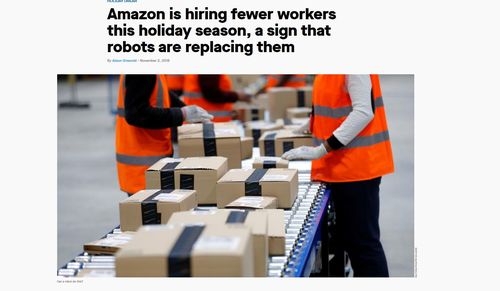Companies usually deny that they incorporate automation to take the place of humans, saying instead that the machines are there to “help” workers or something similarly misleading. But obviously, businesses don’t invest millions of dollars without an eye to saving money in the long run. And Amazon is a top example of how smart machines can fundamentally change how a company performs its functions and become amazingly profitable.
Without owner Jeff Bezos’ decision of buy the Kiva robot system in 2012 to automate Amazon, he wouldn’t now be the world’s wealthiest man with a net worth of $150 billion as of this year.
![]()
Below, Kiva robots bring ordered items from the warehouse to human workers who pack customers’ articles for shipment.
![]()
There’s not a lot that can be done about the approaching automated future, although it makes no sense to continue low-skilled immigration when those jobs will be mostly done by machines in the near future.
Recent news shows that Amazon is continuing to utilize automation to save money by eliminating human workers.
Amazon is hiring fewer workers this holiday season, a sign that robots are replacing them, Qz.com, November 2, 2018
Amazon is staffing up for the holiday rush with around 100,000 additional hires. As big as that number sounds, it’s actually fewer people than the e-commerce giant added in either the 2016 or 2017 holiday seasons, when it brought in 120,000 additional workers.
Citi analyst Mark May says he thinks the reduction in seasonal hiring is strong evidence that Amazon is succeeding with plans to automate operations in its warehouses.
“We’ve seen an acceleration in the use of robots within their fulfillment centers, and that has corresponded with fewer and fewer workers that they’re hiring around the holidays,” May told CNBC on Nov. 2. He added that 2018 is the “first time on record” Amazon plans to hire fewer holiday workers than it did the previous year.
“Since the last holiday season, we’ve focused on more ongoing full-time hiring in our fulfillment centers and other facilities,” Amazon spokesperson Ashley Robinson said in an email, adding that the company has “created over 130,000 jobs” in the last year. “We are proud to have created over 130,000 new jobs in the last year alone.”
Amazon bought robotics company Kiva Systems for $775 million in 2012, and began using its orange robots in warehouses in late 2014. By mid-2016, it had become clear just how big a difference those robots were making. The little orange guys could handle in 15 minutes the sorting, picking, packing, and shipping that used to take human workers an hour or more to complete. In June 2016, Deutsche Bank predicted Kiva automation could save Amazon nearly $2.5 billion (those savings dropped to $880 million after accounting for the costs of installing robots in every warehouse).
Robinson said Amazon has added 300,000 full-time jobs since 2012. ”It’s a myth that automation replaces jobs and destroys net job growth,” she said by email. “Our teams work alongside more than 100,000 robots at over 26 fulfillment centers worldwide and we are excited to continue increasing the technology we use at our sites while growing our global workforce.” (Continues)















